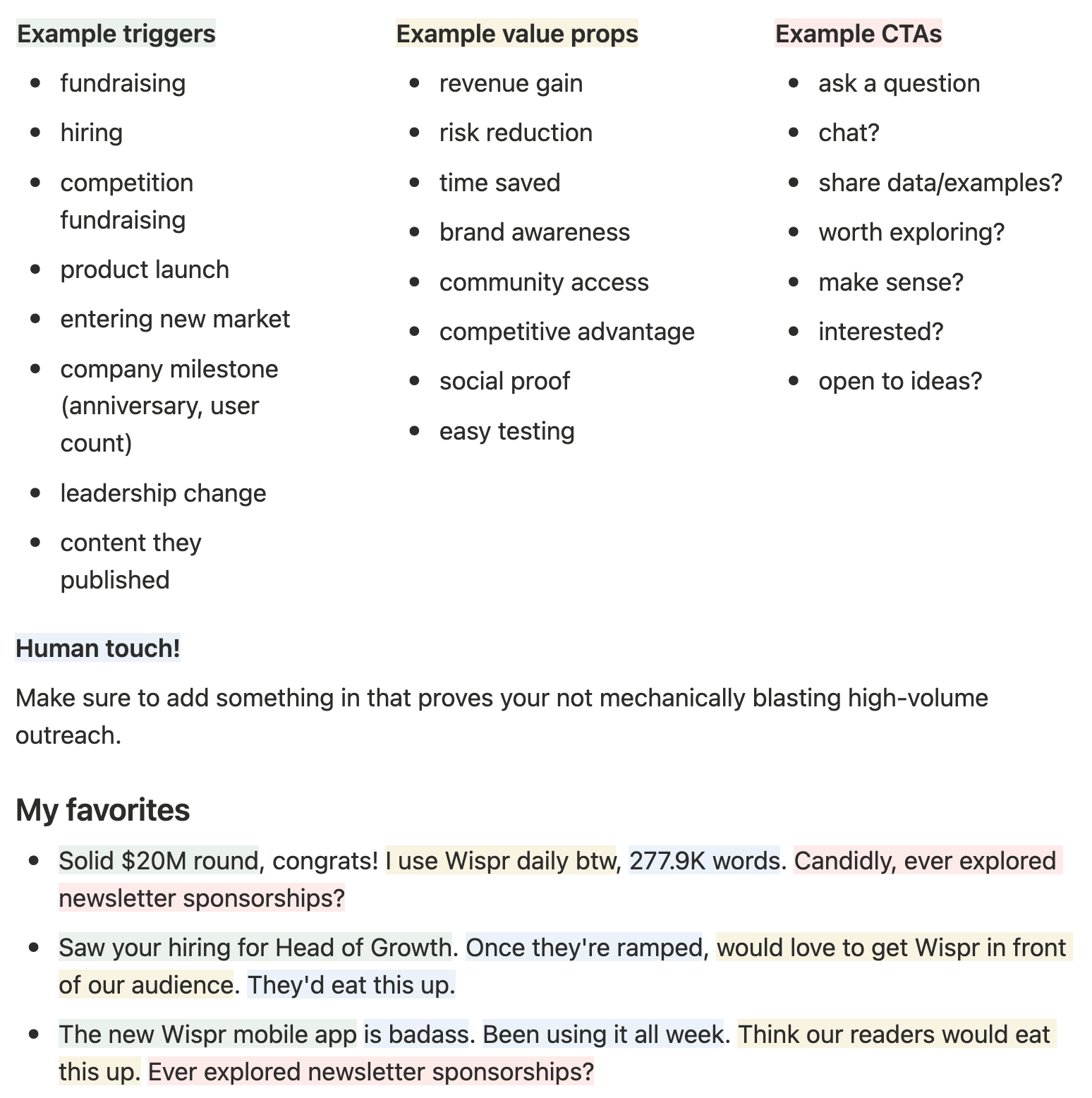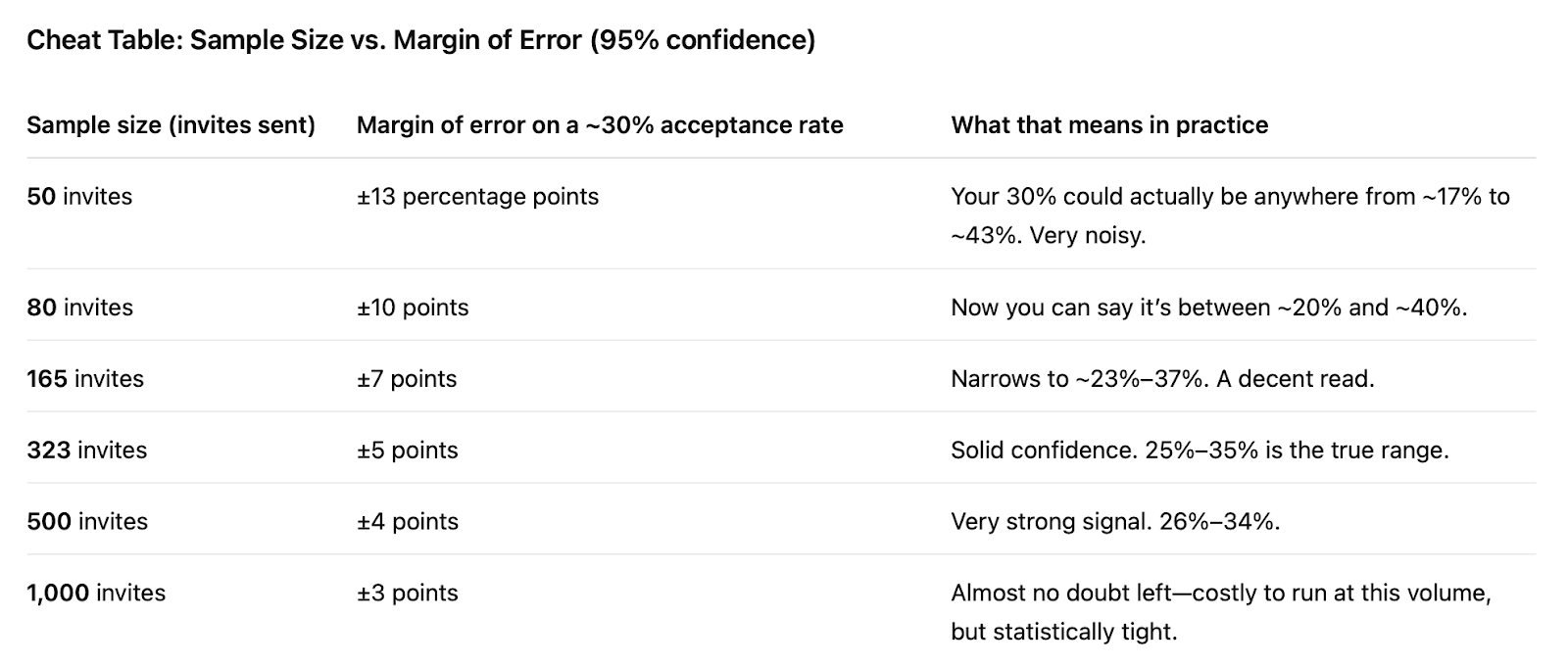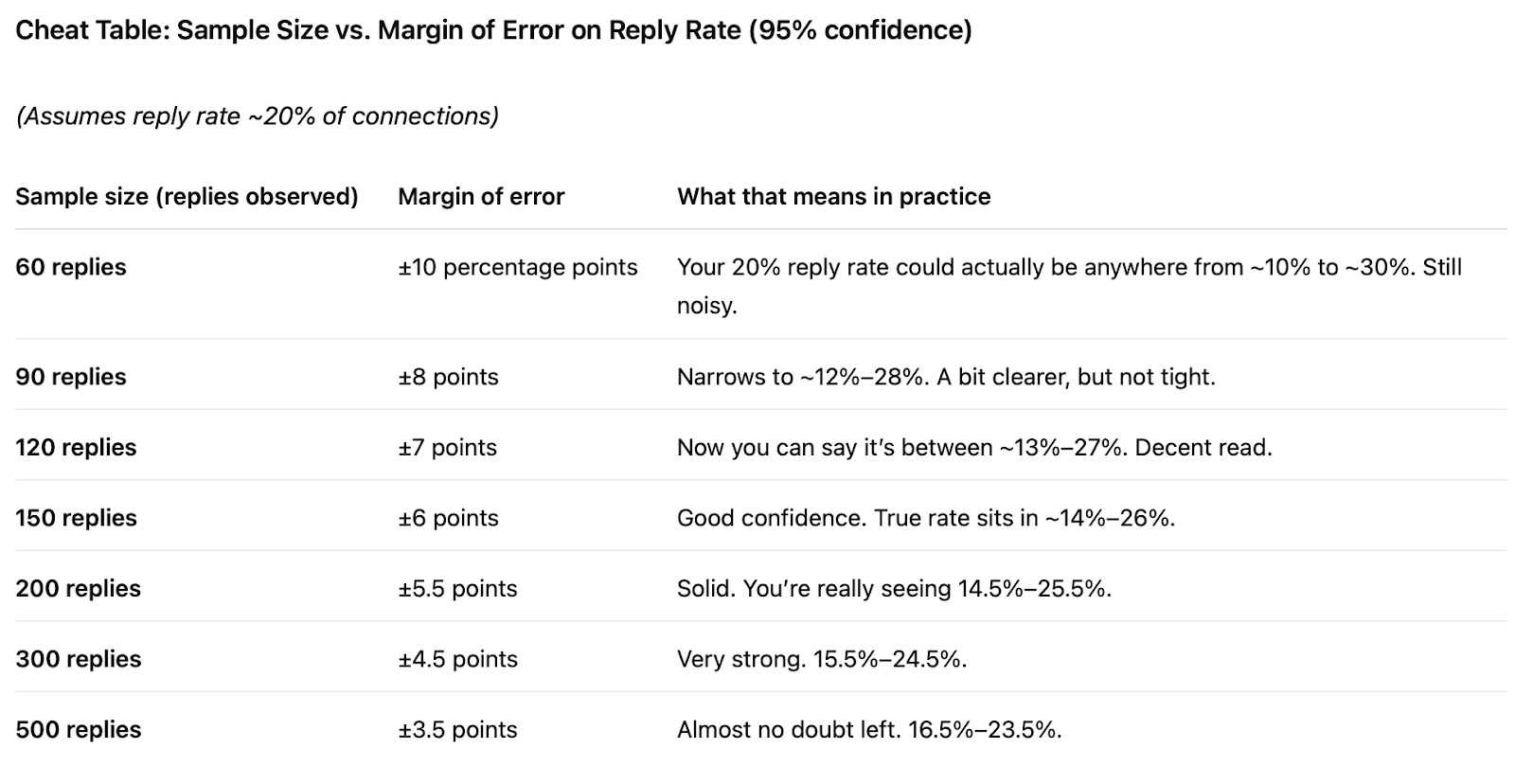
Conversation

🥳 Feedback Received!
Thanks for taking a moment to share your thoughts — it genuinely helps us make each chapter sharper.
What happens next:
- Your feedback goes straight to our product team.
- We’ll use it to refine lessons, clarify examples, and make the program even more useful.
Appreciate you helping make this program better for everyone.
Ready for your next challenge? 👇
Building Your Sales Experimentation Framework
Key Idea: Treat your first outreach efforts like focused, 1-2 week experiments. We'll use the Sales Journal Workbook to define your plan, execute daily, and capture learnings without getting bogged down in complex systems.
Permission Slip: You have permission to be less organized and more scrappy (so you can have more conversations). I know organizing feels productive and valuable, but it's often not. The valuable part is removing all friction and having as many conversations as possible. We're starting with a simple Google Doc - that's it.
Outcome
By the end of this section, you'll have:
- Your "Hypotheses Backlog" section of the Sales Journal Workbook filled out
- A framework for testing smart combinations of who you contact, where you contact them, and what you say
- Your first batch of messages sent
Resources
You'll find these in your course folder:
- Sales Journal Workbook (Google Doc template)
- Funnel Goals Model (Google Sheet)
- Lightweight CRM (Google Sheet)
Phase 1: Formulate Your Hypotheses Backlog
The output of this phase is your first testable hypothesis, which goes directly into your Hypothesis Backlog in the Sales Journal Workbook.
Step 1: Set Your ICP Baseline
This is the "who" of your experiment. Define the companies you're targeting. This goes directly into the ICP Baseline field in your Sales Journal.
- Company Type & Size: Be specific (e.g., B2B SaaS, 10-200 employees, Seed to Series B)
- Trigger: What's a compelling reason to reach out now? (e.g., announced funding in last 90 days, hiring for key role)
- Anti-ICP: Who will you actively avoid? (e.g., consumer-only apps, companies with bad websites)
Step 2: Choose Your Call Points
Within those companies, who are the three specific roles most likely to feel the pain you solve? This goes into the Call Point Roles field in your journal.
- Role 1: VP Marketing or Head of Demand Gen
- Role 2: Head of Growth or Growth Marketing Manager
- Role 3: Founder or CEO (at earlier stage companies)
Step 3: Define Your Channel(s)
How will you start the conversation, and where? This populates the Angle/Trigger and Channel Strategy fields in your journal.
- Channel Strategy: Keep it simple (e.g., "LinkedIn only. Send connection request with no message; send personalized note upon acceptance")
Step 4: Draft Your Messages
Write out a few example messages based on trigger + value prop + CTA angles for outreach:

A Note on Personalization: You need to DISARM: The goal is simple: prove you're not just blasting templated outreach. Add something specific that shows you spent 30 seconds researching them. This could be a recent funding round, a job posting, or content they shared. Then use conversational language - "badass," "btw," "they'd eat this up" - instead of formal sales speak. When you don't have specific personal details, use what Lavender calls "soft variables" from your segmentation: "When I talk to sales leaders at growing software companies..." This shows you understand their world without being presumptuous. Use tentative language like "I could be wrong, but..." or "Worth exploring?" - Lavender's data shows unsure tones get 35% more replies than confident assumptions. The key is sounding like a real person who did basic research and genuinely wants to help, not a salesperson following a script.

Step 5: Add Your Hypotheses to Your Backlog
Now go to your Sales Journal. Take everything from the steps above and log it as a new "Full-Funnel Play Idea" in your Hypothesis Backlog. This formally captures your first experiment before you run it.
Phase 2: Set Your Outreach Target
Step 6: Set Your Weekly Goal & Target Mix
Open your Sales Journal. Based on your "North Star" Goal Math, set your Weekly Outreach Goal and Target Mix.
- Weekly Outreach Goal: ~150 new prospects
- Target Mix: Aiming for a rough 33%-33%-33% split across your roles
Your "This Week's Experiment" section in your journal should now be completely filled out.
Step 7: Prepare to Log Your Learnings
This is your living playbook. You'll come back to this section and add insights as you run experiments. This becomes the most valuable asset you build.
Phase 3: Run the Play
Step 8: Execute and Log Daily
Time to start. Choose your workflow (Account-Driven or Role-Driven) to find prospects on LinkedIn.
Your Daily Rhythm:
- Look at your Sales Journal and your Today's Goal
- Go to LinkedIn and send your connection requests
- Log your actions under the Actions section for the day
- When you get a reply, log it in your Sales Journal under Key Conversations & Learnings
- If the reply is a real conversation, add the individual (with link to their profile) to the CRM tab of your Lightweight CRM sheet
IMPORTANT: Don't log every person you reach out to. Only log your actions (e.g., "Sent 30 invites to VPs of Marketing") and your conversations.
Step 9: Manage Conversations in the CRM (Ultra-Minimalist Method)
When a conversation becomes "real" (they ask for pricing, meeting is booked, they express clear interest), use the Lightweight CRM. This is your "hot list" of active opportunities.
- Your only job: Update the Stage and the Notes
- The Framework: Every time you have an interaction, go to the Notes field for that contact and add:
- Date: (e.g., 9/15/25)
- Note: (e.g., "Replied to my follow-up, booked meeting for Tuesday")
- Action Item: (e.g., "Prep for demo call")
This creates a simple, time-stamped log of your entire relationship.
Step 10: Conduct Your End of Week Review
This is critical for learning. At the end of each week, use the "End of Week Review" section in your Sales Journal to pause, analyze, and plan.
- Progress vs. Goal: Tally your daily logs. Did you hit your activity target?
- Key Wins: What were the positive outcomes? (meetings booked, positive replies)
- What I Learned: This is gold. What did the market teach you this week? What worked? What didn't? Update your "Key Learnings" playbook with validated insights
- Next Week's Focus: Based on learnings, what will you do differently next week? Double down on winning plays or test new hypotheses from your backlog?
Some Remaining Questions
- How do I know how many people to reach out to before I can trust the numbers?
- How do I track this over time so it doesn't get messy?
- What about sequences and follow-ups?
A Note On Statistical Significance


Assignment
- You have your weekly targets using the Goal Math from the previous module
- Open your Sales Journal Workbook from your course folder and complete Phase 1 (formulate your first hypotheses)
- Send your first batch of messages (aim for 25-30 to start)
- Log everything in your journal - actions and conversations only, not individual prospects
What's Next
Now that you have your experimentation framework and journal set up, we'll move into messaging fundamentals and pipeline management. You'll learn how to manage the conversations and opportunities that come from your outreach efforts.


